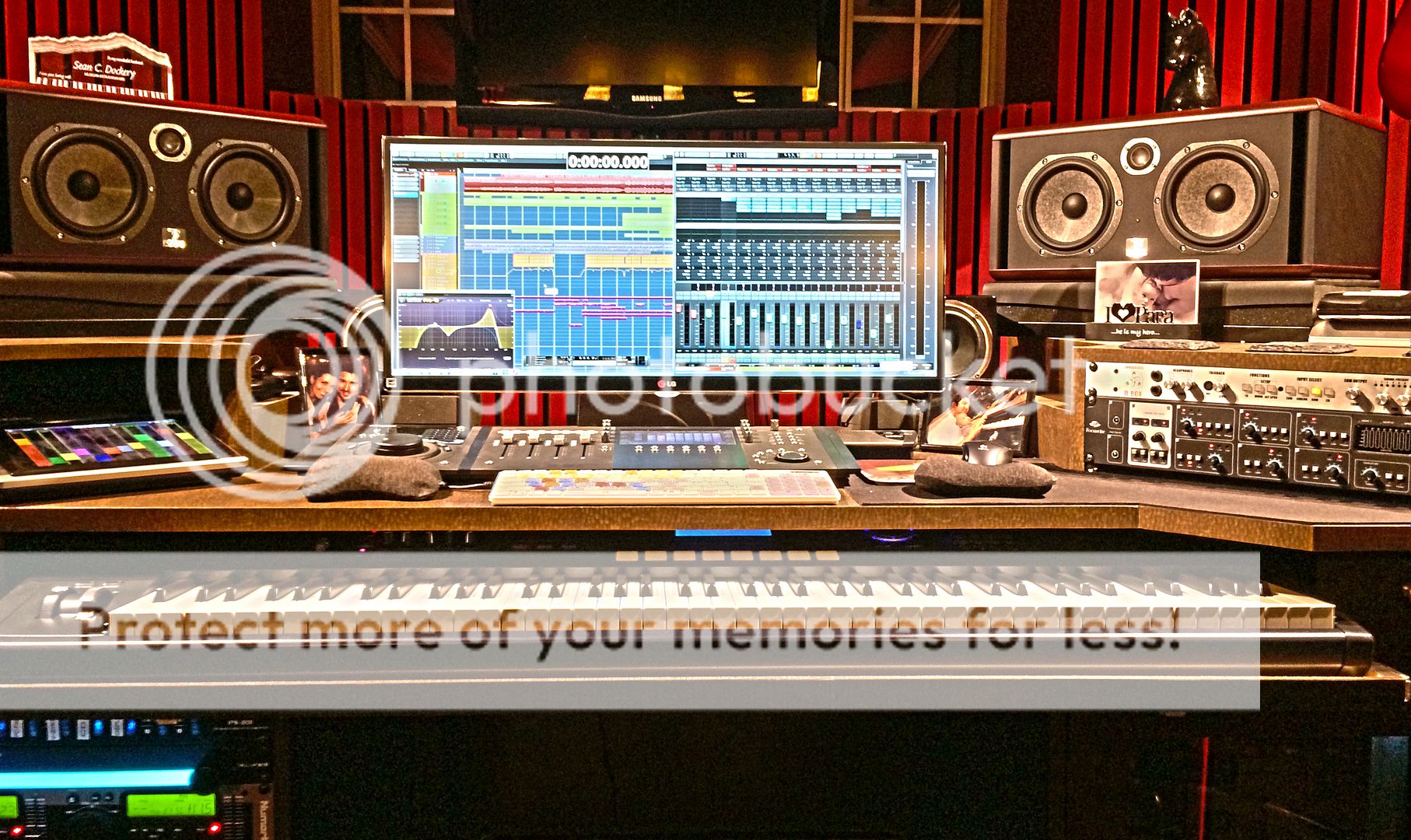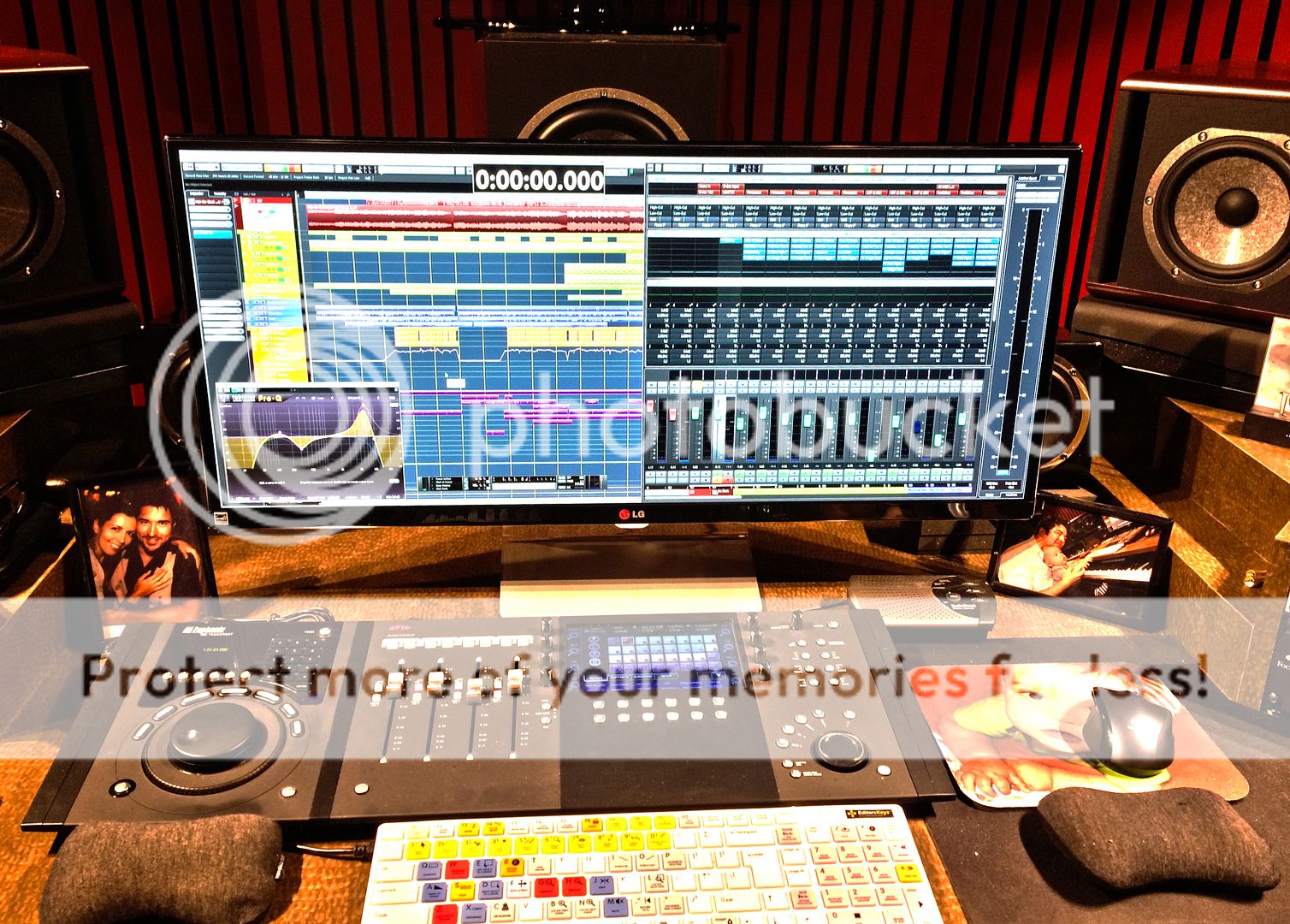I just started using Cubase with dual monitors. Is there a way to move windows like the key editor/score editor outside the workspace? It seems only the transport window can do this. This would make setting up the windows easier and let me have a program other than Cubase be displayed while I work.
Unfortunately, Cubase has severe limitations when it comes to moving windows around. Sure, the mixer can be on a separate screen, so can all the VST’s, but there’s no way to move any editing window (piano roll, scoring etc.) outside of the track page.
That’s why I suggested that Steinberg take a look at Sonar’s Skylight interface, where you can take any window you want and put it anywhere you want, regardless of how many screens you have. Total freedom to move windows around as we please is what we need. Are we going to get it with Cubase 8? I doubt it.
Here’s my simple 3 monitor setup:
19"/22"/19" monitors, works great for me, most things are in view most of the time.
Hi,
Mine dual was (2x20" 1950x1080):
Now (1x27" 2560x1440):
I have very small room, so not many options for now.
I use 3 monitors.
Monitor 1: Arrange window
Monitor 2: Mixer
Monitor 3: Plugins, VSTi rack, etc.
I had 4 monitors set up a long time ago, but I don’t have room for the 4th one in my new setup. I don’t miss it though. 3 is fine for me. It’s a luxury - if I had to work with one or two I’d be ok - but it’s nice to be able to leave the arrange page and mixer uncovered all of the time.
Mine: Project on the left LCD, mixer on the right one. Effects and windows set to “stay on top”, when needed.
Two cheap Dell 19" LCD monitors give me 320 pixels more horizontal real estate than your typical large format $$ LCD (2880 versus 2560). This is very helpful for mixing audio. If you’re a “beats” kinda guy, then maybe more vertical screen might be more useful to organize all those VST instruments and effects… I guess it all depends on your workflow and if you benefit from having a lot of mixer space.
I might add that on my dual 19" screens, the text and controls are a nice “normal” size too. Can’t believe people use 2560 monitors without going blind from eye strain. ![]()
Depends upon the pixel pitch.
Some figures:
a) 19" 1440x900 = 0.28mm
b) 30" 2560x1600 = 0.25mm
c) 27" 2560x1440 = 0.23mm
d) 55" 3840x2160 = 0.31mm
e) 48" 3840x2160 = 0.27mm
f) 32.7" 3440x1440 = 0.23mm = 27" stretched horizontally to 21:9.
The biggest difference is the 55" to the 27", being 1.35:1.
Also, from these figures, a 48" 4K would have 5% less pixel pitch than the 19", but have more pixels and be cheaper than six of them, plus being a whole lot easier to mount, connect, drive, and use, and cheaper to run. Top-of-the-line 3D TV as well.
It comes down to having the right size pixel pitch for your purposes. Too small and some UI elements are too small. Too large and the pixels become too distinguishable, which can make font-scaling (as on web pages or pdfs) not work very well.
I was thinking of buying a MS Surface Pro 3 as my hotel rig (currently using a much larger and heavier 17" HP Elitebook with a 1920x1080 resolution.) But then again, when I consider the SP3’s dot pitch (0.11) vs. my 17" laptop (0.20), everything really looks super-tiny. Realistically, I don’t think I could work with that. IMHO anything below 0.20 is impractical for use with a DAW. Especially if you intend to take advantage of the touch screen (my fingers aren’t exactly super-thin…) Unless, maybe, if you’re young, your vision is perfect and your fingers are extra thin.
The only way to remedy that is to scale up the display, but that:
a) produces lousy looking text when applied to fixed pixel text (best at natural display resolution), as with Cubase
b) defeats the purpose of a hi-res display because it affects the quality of all programs.
By the time one gets the hang of DAWs like Cubase, one fails the first two! ![]()
I am sooooo close to buying this: http://www.lg.com/us/monitors/lg-34UM95-P-ultrawide-monitor?cmpid=2014HEMonitor_SEM_US_Yahoo_UltraWide_UltraWide_Brand_078&utm_source=yahoo&utm_medium=cpc&utm_term=+lg%20+34um95&utm_content=UltraWide_Brand&utm_campaign=2014HEMonitor_SEM_UltraWide
Check out some of the videos on YouTube. This monitor looks incredible and would be perfect for my setup which cannot accommodate 2 large monitors.
Heck with it…I just bought it for $999. Amazon and most other places raised the price to $1179 recently, so I thought it best to jump on it for the $999 while I still could. I will report back on it when I get it…if anyone is interested.
Thanks for sharing this! I’m going to try something similar in the hopes of improving workflow. I just tend to always fall into the same routine of open and closing (mot to mention searching for) way too many windows.
Hi,
Don’t forget to make a picture/printscreen with Cubase on this monitor and post here ! ![]()
Looks like a mixer’s dream monitor!
My only flaw with that rig is one of the reasons I go with two monitors: if one dies (and they always do!), you can keep rockin’ a session on a single monitor with nary skipping a beat and/or replace it with whatever you have lying around until you get the repair/replacement unit back in place. Well… now that I think about it, I suppose that’s primarily my reason for not using an iMac or all-in-one for a production machine.
Yes… let’s see some Cubase screen shots of that Star Trek monitor! ![]()
It would be an ABSOLUTE dream of a mixer monitor if it were a very responsive touch screen…
I will definitely take some photos and do some print screens once I receive it next week. This thing will be awesome with my new I7 5930 (with 4 TB all SSD’s) DAW I just build this week. Touch screen would be nice, but I’m seriously thinking of going for a Raven MTI next year anyway.
Cubase limitations
While Cubase is still touch-dumb, large touchscreens have limited use.
Default Windows touch capability is only one touch location at a time with some one and two finger gestures, though a program can access multiple touch locations. With the former, touch is basically an alternative to using a mouse.
While I have two Dell 23.5" ST2340T 1920x1080 touchscreens, they are of limited use in Cubase because:
a) Many controls are too small to use a finger with. The scrub controls are tedious and fiddly enough with the mouse, but almost impossible with touch.
b) Only one control can be manipulated at a time. That is across all touchscreens. Makes realtime automation writing virtually impossible with touch.
c) The further a control is from an edge, the less accurately finger-placement is (unless you are Stephen Wiltshire, the savant who can draw details for hours without hand support). This is because Cubase cannot ignore non-control screen areas, which could be used by fingers for support.
Even with these limitations, having all screens with touch would allow them to be used for the quick direct touch to a control, instead of a multi-step process with the mouse or keyboard.
So until SB stops limiting Cubase by OSX’s limitations, we will not see much progress there.
Touch monitor limitations
Unfortunately, current monitor touch technology is limited in that:
a) it adds significant expense. And after-fit alternatives are not cheap either.
b) distance between the screen and the touch surface is a few mm, which means that they are best used so that you are looking at them as directly as possible, especially with small controls, otherwise the parallax distortion will result in a lot of off-centre touches.
Human limitations
Basically, our arms get tired the longer we hold them up, so for frequent long-tem use, we need:
a) some dead areas on a screen with which we can use a finger or two, or a hand edge, to support our hands, otherwise we will tend to favour a mouse for accurate control manipulation.
b) monitors to be closer to us and at an angle like 45o, so they are easier to get to and see the details.
Touch monitors holding mainly non-interactive content, can still be vertical.
iC Pro
SB seems to have focussed their touch efforts into phones and tablets, and have produced a very flexible app for iOS and Android (Windows when?) that allows many of them to be used together to control multiple Cubase functions simultaneously. Certainly, the cue mixer is a huge improvement over trying to use Cubase itself.
iC Pro can be used to provide arrays of buttons to touch enable a lot of Cubase functionality, but I don’t think the app can yet provide an 8-channel slice of the mixer, like control surfaces can via the RC devices interface.
However, while one could have lots of devices running iC Pro, they are not much use for anything else, so might be in the way for non-DAW use, whereas touch monitors can still be used for any ancillary Window programs, like Outlook, to keep the main monitor(s) less cluttered.
Yep. On the other hand, Sonar X3 is an absolute delight to use with a touch screen. It’s because they have no OSX version, so they can actually be up-to-date with modern technology. That’s where Steinberg should look for inspiration. But we know that deep down they’re all Apple fanboys (ever seen a Steinberg booth at a trade show? Looks like an Apple booth, even though everybody knows Cubase runs better on Windows…), so you know the story: a touch screen is useless until Apple starts releasing Macs with touch screens… (mark my words, it WILL happen. Sooner than you think. And last year --when all the Apple heads were making fun of my Samsung Note III for being “ridiculously big”-- I predicted that Apple would release a phablet within 1-2 years…) Once Apple adopts it, the touch screen on a laptop/desktop will suddenly become super cool and, naturally, Apple will say they invented it (and maybe a lawsuit against Microsoft will be filed…) Kinda like smaller tablets and larger phones/phablets… ![]() Apparently, it doesn’t matter to Steinberg that most of their customers actually use Windows…
Apparently, it doesn’t matter to Steinberg that most of their customers actually use Windows…



